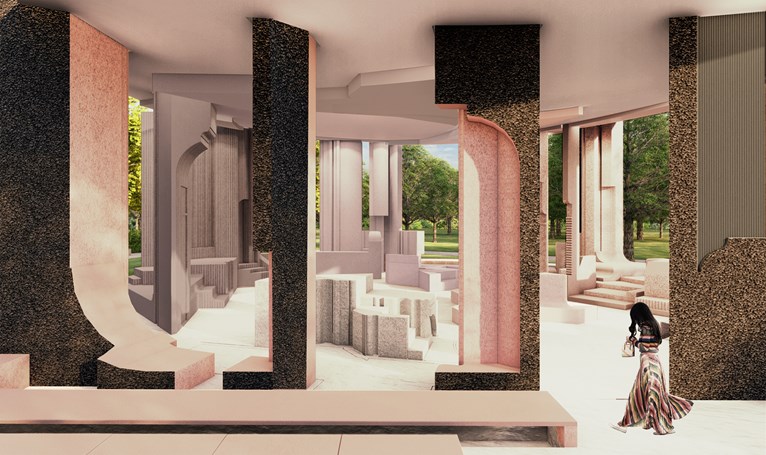
Serpentine Pavilion 2020 designed by Counterspace, Design Render, Exterior View ©Counterspace
For the first time since the annual architecture programme was founded 20 years ago, the 2020 Serpentine Pavilion designed by Johannesburg-based practice Counterspace has been extended into a two-year commission.
Counterspace, directed by Sumayya Vally, Sarah de Villiers and Amina Kaskar will collaborate with the Serpentine on a series of off-site and online research projects throughout 2020, which will culminate with the opening of the Pavilion in Summer 2021.

Amina Kaskar, Sumayya Vally and Sarah de Villiers of Counterspace. Photographed by Justice Mukheli in Johannesburg, 2020. ©Counterspace
Using both innovative and traditional building techniques, Counterspace’s design will be based on gahering spaces and community places around the city, folding London in to the Pavilion structure in Kensington Gardens, and extending a public programme across London. The shapes of the Pavilion are created from a process of addition, superimposition, subtraction and splicing of architectural forms, directly transcribed from existing spaces with particular relevance to migrant and other peripheral communities in London.
On its 20th anniversary, more than ever, the Serpentine Pavilion will be a place for debate and new ideas. Connecting to the Serpentine’s ambitious multi-platform project Back to Earth, the Pavilion and sets out to explore questions such as: how can architecture create a space where we are all linked, not ranked? How can architecture promote wellbeing? Can a structure evolve and change together with the environment?
The Pavilion will include moveable small parts that will be displaced to neighbourhoods across London. Following community events at these locations, the parts will be returned to the structure, completing it over the summer. Employing a mix of low-tech and high-tech approaches to sustainability, the Pavilion will be constructed from a variety of materials, including custom K-Briq-modules and cork provided by Amorim. K-Briqs are made from 90% recycled construction and demolition waste and are manufactured without firing, with a tenth of the carbon emissions of normal bricks.

Serpentine Pavilion 2020 designed by Counterspace, Design Render, Interior View ©Counterspace
The lead architect on the project, Sumayya Vally of Counterspace, said of the design:
"We've always relied on places of gathering to come together and we miss them when they're gone. COVID-19 has brought the Pavilion themes of community and gathering sharply into focus - allowing us the opportunity to extend and deepen our engagement process over two years. We are excited to launch a set of initiatives that will redefine and celebrate the role of gathering and the construction and preservation of belonging in times of crisis - reversing the original procession, so that a cascade of dialogues, events, programmes, and fragments of the Pavilion will pop-up incrementally in real and digital space over the course of 2020 coming together in 2021 in Kensington Gardens to form Pavilion 20 plus 1."
“The pavilion is itself conceived as an event — the coming together of a variety of forms from across London over the course of the Pavilion’s sojourn. These forms are imprints of some of the places, spaces and artefacts which have made care and sustenance part of London’s identity. The breaks, gradients and distinctions in colour and texture between different parts of the Pavilion make this reconstruction and piecing together legible at a glance. As an object, experienced through movement, it has continuity and consistency, but difference and variation are embedded into the essential gesture at every turn.
Places of memory and care in Brixton, Hoxton, Hackney, Whitechapel, Edgware Road, Peckham, Ealing, North Kensington and beyond are transferred onto the Serpentine lawn. Where they intersect, they produce spaces to be together."
Bettina Korek, CEO, and Hans Ulrich Obrist, Artistic Director, Serpentine Galleries said:
“Counterspace’s Pavilion has developed in tandem with Back to Earth, our multi-year initiative responding to the environmental crisis. Ecology, community, and other themes of Back to Earth are intrinsic to Counterspace’s practice as well, and these have only grown more meaningful during this time of social distancing and planetary struggle. We are fortunate to have this opportunity to take more time to collaborate with Counterspace and our community partners on their commission. Back to Earth inaugurates our commitment to making “Slow Programming” that expands beyond the conventional limits of museum activity. We are grateful to the architects for their vision and to all our supporters who make it possible for us to continue our work of evolving the Serpentine's role in a rapidly changing society.”
Click to download the full press release


comment